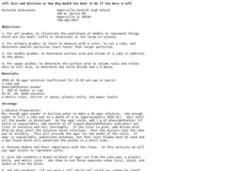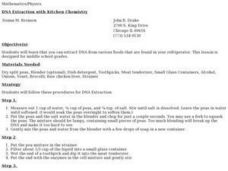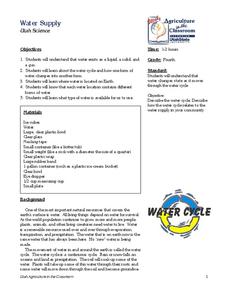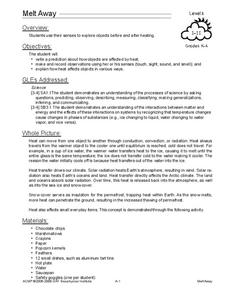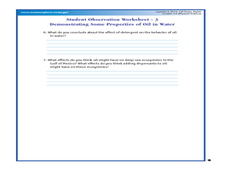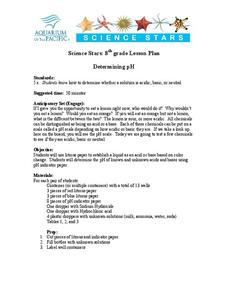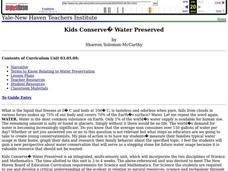Curated OER
Baking Soda vs. Baking Powder
For this chemical reactions worksheet, students by comparing the chemical reactions of baking soda and baking powder. This worksheet has a graphic organizer and 7 short answer questions.
Curated OER
Basics of Science
In this basics of science worksheet, students review the metric system, the difference between homogenous and heterogenous mixtures, the scientific method, and science lab first aid. This worksheet has 15 short answer, 43 fill in the...
Curated OER
Density Lab
Students find the density of two substances. In this density lesson plan, students determine the density of water and ethyl alcohol and compare their densities. They enter their data into the computer to produce a class compiled graph....
Curated OER
WS 7.5 Thermodynamics Concepts and Vocabulary
In this thermodynamics worksheet, students fill in the blanks with terms related to specific heat, calorimetry, phase changes, enthalpy, entropy and free energy.
Curated OER
Practice Evaluating Experimental Designs
In this experimental design worksheet, students evaluate experiments using a design checklist. They suggest ways to improve the experiments and they identify all the components of the design.
Curated OER
Integrating Physics-Observing and Experimenting to Find Relationships
In this experimental relationship worksheet, students read about direct and indirect relationships between variables in experiments. They answer three questions about relationships between variables.
Curated OER
Conservation During Chemical Reactions
In this chemical reaction worksheet, learners are given the details of an experiment where sodium chloride and silver nitrate are mixed in a chemical reaction. Students answer nine questions about the chemical reaction, they determine...
Curated OER
Health Education: Dental Flossing
Third graders do dental flossing. In this dental care lesson plan, 3rd graders demonstrate proper dental flossing technique and describe the benefits of flossing.
Curated OER
Cell Size and Division or How Big Would You Want To Be if You Were a Cell?
Students investigate why cells divide. In this cell size lesson plan, students observe how far a solution travels into 3 different size model cells of agar. They answer questions about the most effect movement of "nutrients" into the...
Curated OER
DNA Extraction with Kitchen Chemistry
Students extract DNA from green peas. In this DNA extraction lesson plan, students use a blender to chop up peas, they mix them with a little soap, they tenderize them and they mix them with alcohol to see the DNA precipitate through the...
Curated OER
Diffusion
Students investigate diffusion using different solutions of chemicals placed in agar dishes. In this diffusion lesson plan, students observe 3 demonstrations of diffusion using perfume, food coloring in water and sugar cubes in water....
Curated OER
Chemistry Is a Gas
Young scholars investigate the gas laws and how they apply to changes in gases. In this gas laws lesson, students use Boyle's Law and Charles' law to show the relationships between pressure and volume and volume and temperature of gases.
Curated OER
Water Supply
Fourth graders complete three activities. In this water supply lesson, 4th graders learn that water can exist in different forms and watch a demonstration of each form. Students explore the water cycle and make a water cycle using the...
Curated OER
Three Clouds Activity
Students understand how clouds are formed. In this cloud lesson, students participate in three experiments to make clouds. Students complete activity sheets for each experiment.
Curated OER
Melt Away
Students explore objects before and after heating using their senses. In this matter and energy lesson, students experiment with a variety of objects and use their senses (except taste) to make predictions and record observations...
Curated OER
Convection and Wind
Students use water, beakers, hot plates, paper dots, and goggles to participate in a hands on activity where they see how a convection current creates wind. In this convection current lesson plan, students participate in a hands on...
Curated OER
Now you see it....Now you Don't
Young scholars investigate the biodegrading process of packing peanuts. In this biological process activity, students conduct an experiment to see how quickly packing peanuts biodegrade. Young scholars check the process each day and...
Curated OER
Watch Me Grow
Students observe that plants need air, food, light, and water to survive. In this plant biology lesson, students observe the growth and development of two plants, one is the control plant and the other is denied either air, water,...
Curated OER
Oil Floats, Right?
Students examine the properties in oil in water. In this mixture lesson, students read about the Lophelia II 2010: Cold Seeps and Deep Reef Expedition and look at images of deep sea ecosystems. They experiment or participate in...
Curated OER
Osmosis and Diffusion: Egg Lab
Students examine why diffusion and osmosis happen in an egg cell. In this diffusion lesson plan students demonstrate a semi permeable membrane.
Curated OER
Growing A Coral Skeleton
Students research the growth of coral. In this coral polyps lesson, students simulate the growth of coral by using available materials to grow crystals. Students record observations in a scientific journal.
Curated OER
Determining pH
Eighth graders explain the difference between acids, bases and neutral solutions. In this chemistry lesson, 8th graders describe the properties of each. They determine the pH of an unknown solution using the indicator paper and pH scale.
Curated OER
The Spectrum of a Star
Tenth graders identify stars based on their line spectra. In this astronomy lesson, 10th graders analyze spectrograph and determine the elements present in the star. They explain the relationship between temperature and star classes.
Curated OER
Kids Conserve? Water Preserved
Middle schoolers study conservation and how cities obtain their water. In this water lesson students view a PowerPoint presentation and draw a picture of the water cycle.
Other popular searches
- Measuring Liquids and Solids
- Metric Measuring Liquids
- Measuring Liquids in Math
- Measuring Liquids Lab
- Measuring Liquids and Masses










